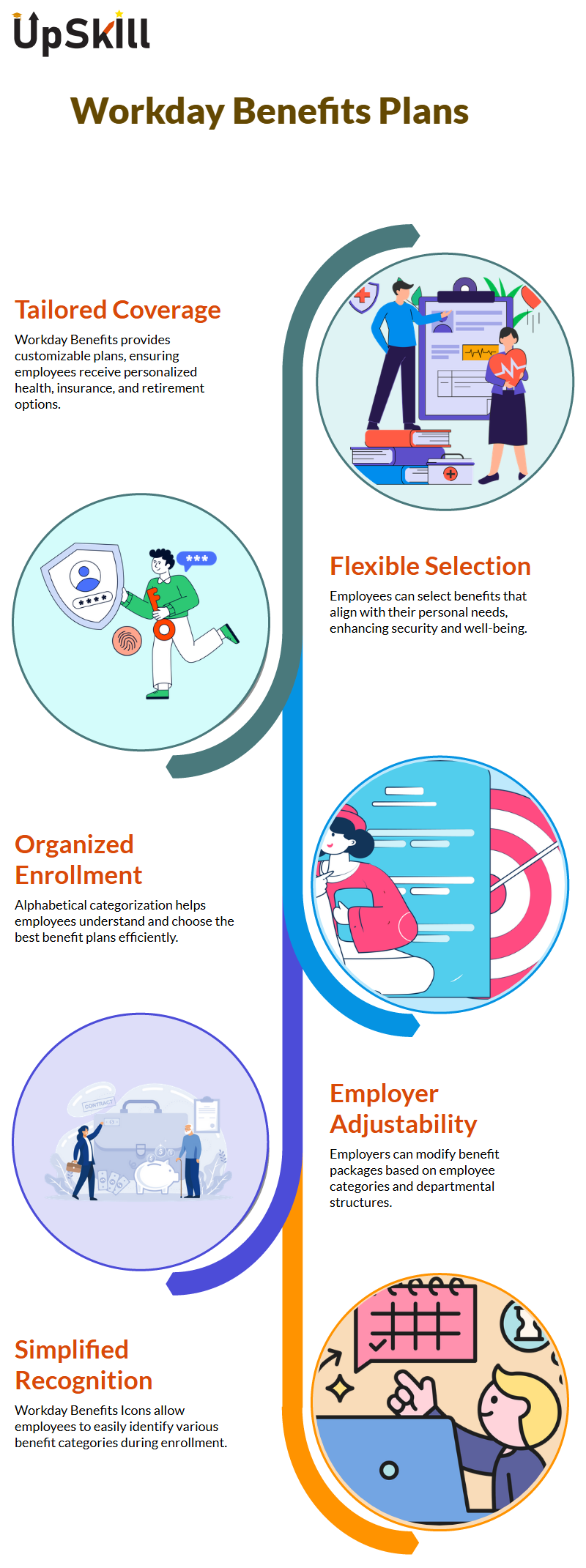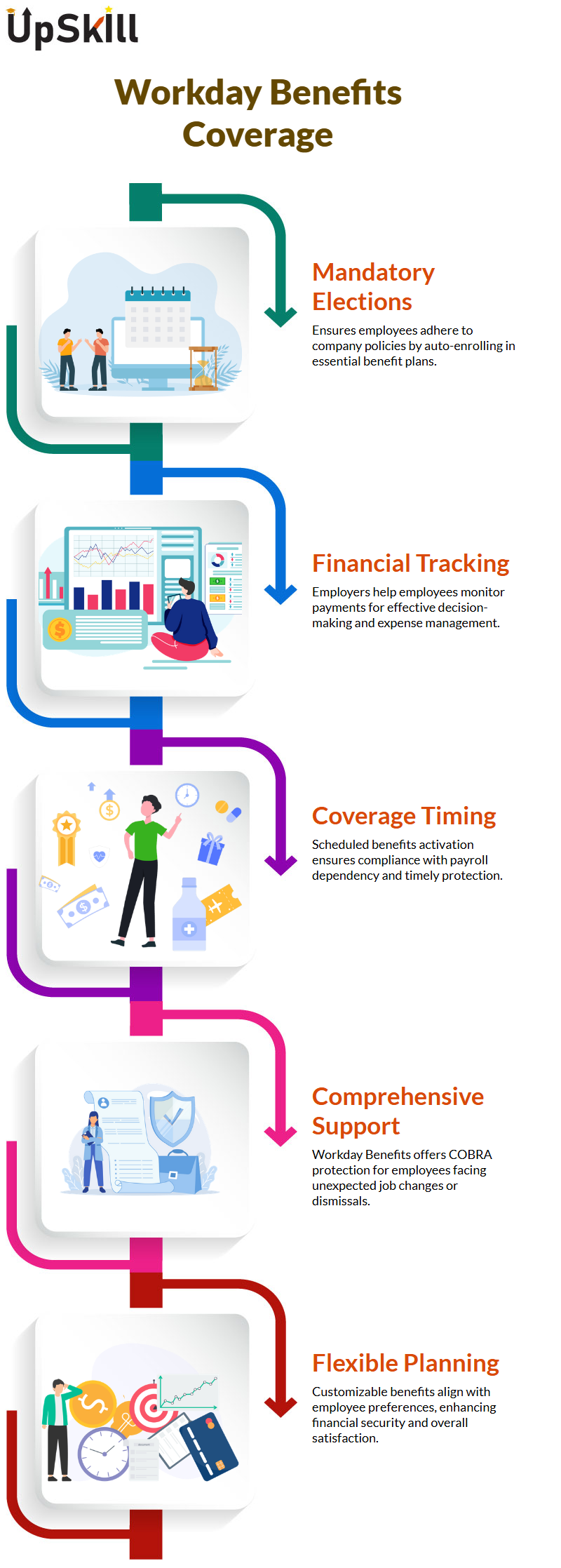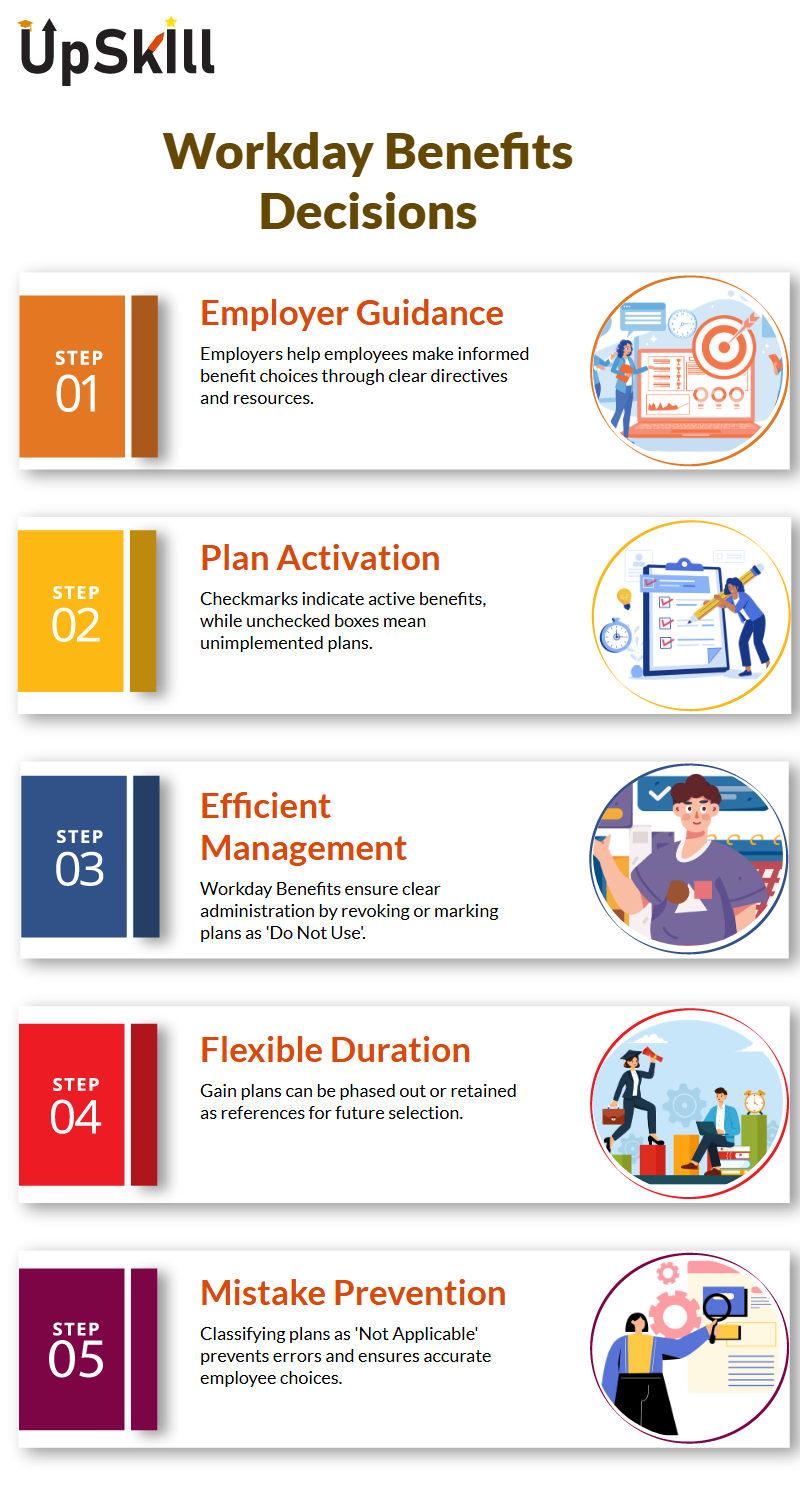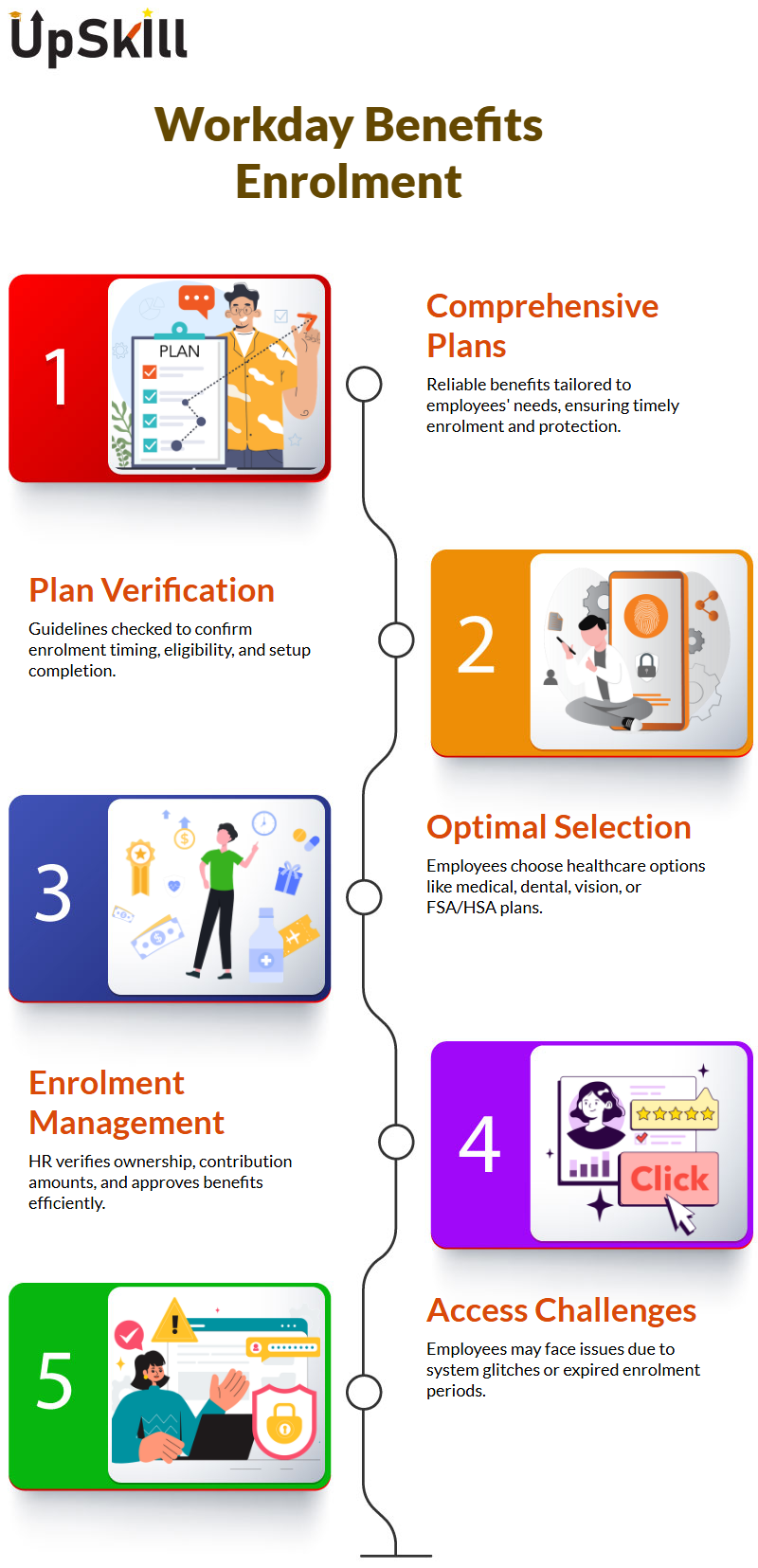Top Workday Training Institutes in Bengaluru near me
Workday Benefits Tutorial
Structured Plans for Personalised Employee Security through Workday Benefits
Workday Benefits begins by selecting Power S plans that specifically protect employees, ensure they receive tailored coverage with customised plans tailored to their needs.
Our handout, which includes health, insurance, and retirement coverage, as well as extra options, can offer both financial security and well-being for individuals.
It offers a range of benefits, including health insurance, retirement planning, and additional options, allowing employees to select benefits that suit their personal needs.
These options include healthcare coverage, retirement services, and extra choices that enhance an employee’s comfort with their retirement planning strategies and selection processes.
Employees who are aware of their own needs are better equipped to make more informed decisions from this selection process.
One of the hallmarks of Workday Benefits is how its plans are displayed to employees during enrolment.
If eligible, employees may qualify for multiple plans, such as Plan A, B, or C, depending on when and how they enrol in them.
When conducting a Workday Benefits Tutorial in Bengaluru, organising the Workday Benefit plans alphabetically can greatly assist employees in understanding and selecting the best options.
When two or more Workday Benefits display in a similar order, this alphabetical organisation should be employed.
Naming standards enhance the functionality of Workday Benefits.
Employee data must align with company projections. Decision-makers should select plan names carefully.
Employees are given the freedom to choose Workday Benefits that they believe offer them the most advantage or support.
Employee Engagement Through Flexible Workday Benefits
Workday Benefits does not mandate that specific coverage be included.
Instead, employers have the freedom to decide how an amount will be expressed, as either a fixed amount or a percentage.
They can also invite workers’ ideas by specifying types of minimum and maximum coverage plans, as well as other related categories.
Employers also retain control in selecting employee-only plans versus employer-only ones.
Organisations attending the Workday Benefits Tutorial in Bengaluru discover how Workday Benefits Adjustability allows them to personalise benefits packages according to employee categories and departmental information.
Some departments can reduce benefits while executives modify predefined settings accordingly for the redesign of plans, providing enterprises with an organised method for allocating benefits across departments and employee levels.
Workday Benefits Icons help employees quickly recognise what categories their benefits encompass when enrolling through Workday.
Employers can select appropriate icons representing health, retirement, and any other type of benefit, so that when enrolling employees, they don’t experience difficulty knowing exactly which features make up their Workday benefits package.
Employers leveraging Workday Benefits may wish to set election limits in Workday Benefits to limit the frequency with which employees can elect coverage under specific benefit plans.
Such plans typically offer similar types of protection and require employees to opt in annually. Employers that set election limits also help facilitate selection processes more smoothly.

Mandatory Elections and Financial Visibility in Workday Benefits Plans
Workday Benefits systems often employ mandatory elections as part of their perk systems to ensure employee coverage adherence.
Sometimes, plans themselves provide this feature, so employees don’t need to opt in individually for coverage; such methods help ensure employees are upholding company policies.
In the Workday Benefits Tutorial in Bengaluru, it is recommended that Workday benefits include all expenses relevant to most companies.
Employers may set up systems to enable employees to keep an accurate tally of what their payments are going toward a plan.
In doing so, more effective decisions may be reached by both the employer and employees alike.
According to the Workday Benefits tutorial in Bengaluru, starting coverage on specific plan year dates rather than instant enrolment helps maintain payroll dependency compliance and guarantees timely benefits activation.
These instances must meet specific, predefined configuration requirements to activate benefits on schedule.
Future-Proofing Employee Support with Comprehensive Workday Benefit Planning
Workday Benefits provides its employees with comprehensive protection, even in the event of an unexpected job change or dismissal, offering access to COBRA benefits to ensure their finances and those of their dependents remain secure.
To ensure the well-being of its employees and protect the futures of those they employ, a company’s Workday Perk system should account for situations like the COVID-19 pandemic, health concerns, or sudden job loss, and offer valuable solutions that safeguard both employees and their families.
Learning the ins and outs of Workday Benefits, as covered in the Workday Benefits Tutorial in Bengaluru, is essential to making informed decisions.
Team leaders should help their staff members understand different benefit structures as they select plans that best meet their financial and health needs.
Aligning Employee Expectations with Flexible Workday Benefit
Workday Benefits roster arrangements provide flexible solutions that can easily adapt to fit each employee’s personal preferences and lifestyle needs.
Employees have access to various insurance, retirement, and wellness offerings, while plans may also be tailored to promote long-term financial security.
Enterprises that adopt Workday Benefits systems, as highlighted in the Workday Benefits Tutorial in Bengaluru, should maintain regular checks to ensure compliance with industry standards and employee satisfaction.
When benefits align with employee expectations, employee satisfaction increases significantly.
These are essential in providing financial protection during times of hardship, and effective planning and communication make the benefits even more suitable to employees.

The Role of Employers in Shaping Smart Workday Benefit Decisions
People considering Workday Benefits should make an effort to thoroughly research all available options before selecting one that aligns with their personal financial and health objectives.
Employers serve as architects in the Workday Benefits realm, often guiding employees through platforms like the Workday Benefits tutorial in Bengaluru.
By offering clear directives and resources, employers ensure employees make well-informed decisions regarding Workday Benefits.
Strengthening Workday Benefits can help organisations establish an environment in which frontline staff receive full support and appreciation, with an effective compensation system reinforcing job fulfilment, retention, and overall workplace harmony.
Comprehension Workday Benefits
Workday Benefits provides an intuitive, user-friendly, and efficient way to manage employee benefits effectively.
When setting up benefit plans, it is vitally important to determine their status, in other words, whether the plan has become active yet.
A checkmark next to a coverage type indicates its active use, while an unselected box means it has not yet been implemented.
Users learn in the Workday Benefits tutorial in Bengaluru that after a coverage type is created and selected in Workday Benefits, it is no longer possible to delete it.
When an employer wishes to revoke it altogether, one option is to designate it as “Do Not Use.”
Then, uncheck all appropriate boxes within Workday benefits to ensure benefits are administered efficiently and clearly.
Making Use of Workday Benefits in the Best Possible Way
Gain plans vary in their duration, some last for longer, while others may be cancelled if employees no longer require them.
Employees who are no longer eligible to use certain Workday Benefits will have their plans phased out, but will be retained within the system as references.
Understanding all available options, as highlighted in the Workday Benefits tutorial in Bengaluru, is essential because Workday Benefits presents all choices to users at once.
Avoiding the Usual Mistakes in Workday Benefits
An issue in managing it arises when employees or employers want to delete coverage types, but there is no direct way to do so.
By classifying it as “Not Applicable” and isolating this item from employees, no information that might lead to mistakes will remain, which could mislead employees into making wrong choices.
As covered in the Workday Benefits tutorial in Bengaluru, every plan within Workday Benefits undergoes an extensive review to mitigate future complications and ensure Client approval of selected items.
When coverage for specific categories has been initiated, not only may adjustments be made, but deletions can also occur at any time.

Benefits Awareness and Enrolment through Workday Benefits
Workday Benefits has long been recognised for its reliability in providing employees with comprehensive plans that suit them precisely, at just the right time and place.
Their assignment of value plans remains at the core of everything we do as business partners, and it defines when an employee must sign up.
Attaining each detail from eligibility assessment through to plan definition remains key in meeting this promise of comprehensive protection for your staff members.
Setting Up Employee Advantage Plans via Workday Benefits
Workday Benefits provides tools and techniques for crafting plans that fit employee needs—something the Workday Benefits tutorial in Bengaluru emphasises through its focus on shaping and setting.
A beneficial option would be renaming it the “AMD Advantage Plan.”
After outlining, verification should occur to ensure that guidelines have been fulfilled as promised and that employees enrol on time.
At this stage, all arrangements, date verification, and configuration setup are finalised.
Managing Your Benefits in Workday
Selecting an optimal Workday Benefits option is essential, as individuals need to choose plans that best meet their healthcare concerns, whether those be medical, dental, visual, or FSA/HSA coverage.
When making this selection, it should cover employees in all aspects of well-being, regardless of a given period or plan type available to them.
Controlling Employee Enrolments and Contributions via Workday benefits
In the Workday Benefits tutorial in Bengaluru, users are shown how Workday Benefits simplifies and optimises enrolment administration.
When an employee selects a plan from Workday Benefits, HR staff must first validate ownership, determine the contribution amount, and approve the prototype request before it goes live.
Using Metro Try and Pass ensures that coverage will go into effect successfully.
Typically, employees who do not view benefits have one of two explanations in mind.
Either they cannot access them due to system glitches, or their enrolment period has expired before the timeframe was reached.

How to Review and Manage Your Coverage in Workday Benefits?
Workers and employers can both verify the accuracy and processing of Workday Benefits enrolment and deductions, respectively.
As outlined in the Workday Benefits tutorial in Bengaluru, employers can verify whether workers have active coverage through the system.
They may choose from various options available, such as providing only summary data while keeping details unviewable, to protect sensitive information while offering maximum employee benefits at once.

